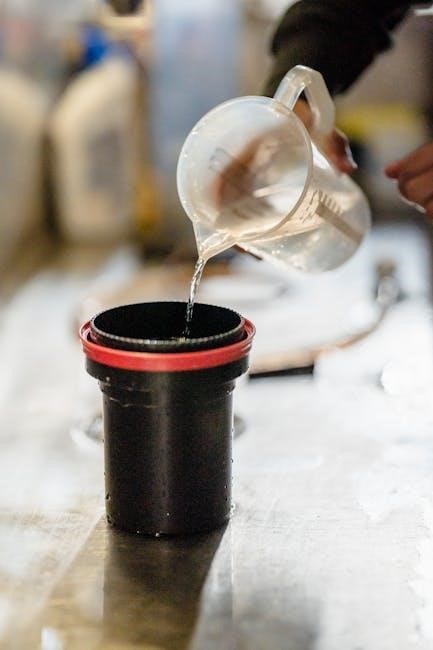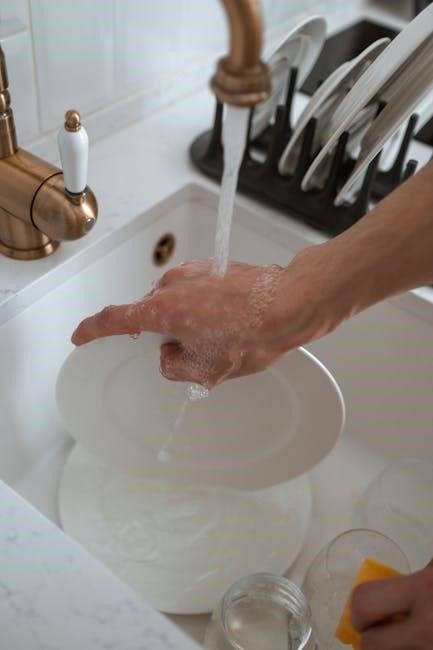The Atwood Water Heater Manual is a comprehensive guide covering installation, operation, and maintenance. It ensures safe usage, providing essential instructions and troubleshooting tips for optimal performance.

1.1 Overview of the Atwood Water Heater
The Atwood Water Heater is a popular choice for RVs and motorhomes, offering reliable hot water solutions. Models like the G6A-7 and MPD 93756 are designed for efficiency, with capacities ranging from 4 to 10 gallons. These heaters are available in gas, electric, or combination models, catering to diverse needs. The Atwood Water Heater features a durable design with cladding for exterior protection and easy servicing. Most maintenance can be performed externally, simplifying upkeep. The unit is equipped with safety features like temperature controls and an ECO switch to prevent overheating. With a user-friendly interface and energy-efficient operation, the Atwood Water Heater is a practical and reliable option for recreational vehicles. This manual provides detailed insights into its features and operation.
1.2 Importance of the Manual
The Atwood Water Heater Manual is a crucial resource for safe and effective use of the appliance. It provides detailed instructions for installation, operation, and maintenance, ensuring optimal performance. The manual highlights essential safety precautions to prevent hazards like fire or explosion. By following the guidelines, users can troubleshoot common issues and perform routine checks to extend the heater’s lifespan; Understanding the manual is vital for compliance with safety standards and proper functionality. It serves as a reference for diagnosing error codes and addressing operational problems. Regularly reviewing the manual ensures users are aware of critical safety features and maintenance requirements, helping to avoid potential risks and ensuring reliable hot water supply.
1.3 What to Expect in the Manual
The Atwood Water Heater Manual provides a detailed guide for users, covering installation, operation, and maintenance. It includes step-by-step instructions for proper setup and configuration, ensuring safety and efficiency. The manual outlines routine maintenance checks, such as inspecting electrical connections and gas lines, to prevent issues. Troubleshooting sections help diagnose common problems, like error codes, and offer DIY fixes. Technical specifications and warranty information are also included, giving users a clear understanding of their product’s capabilities and support options. By following the manual, users can optimize performance, extend the heater’s lifespan, and ensure safe operation. It serves as a one-stop resource for all aspects of Atwood water heater ownership.

Installation Guide
The manual provides a comprehensive installation guide, covering location requirements, step-by-step processes, and electrical/gas connections, ensuring safe and proper setup of your Atwood water heater.

2.1 Location Requirements for Installation
Proper location is crucial for safe and efficient operation. The Atwood water heater must be installed in a well-ventilated area, away from flammable materials and combustible vapors. Ensure the location complies with local building codes and regulations. The heater should be positioned on a level surface to prevent tilting, which could lead to improper function or safety hazards. Avoid installing near living spaces or areas where condensation might occur. Keep it at least 18 inches above the floor to protect against flood damage. Ensure proximity to a gas supply line and electrical connections, as specified in the manual. Always follow the manufacturer’s guidelines for optimal performance and safety.
2.2 Step-by-Step Installation Process
Begin by preparing the installation site, ensuring it meets the specified location requirements. Carefully unpack the Atwood water heater and inspect for damage. Mount the heater securely on a level surface, using the provided hardware. Connect the gas supply line to the designated inlet, ensuring no leaks. Next, attach the electrical connections, following the wiring diagram in the manual. Install the venting system according to the manufacturer’s instructions to ensure proper ventilation. Finally, test the system by running a full cycle to check for leaks and proper function; Always follow local building codes and safety guidelines during installation.

2.3 Electrical and Gas Connections
Proper electrical and gas connections are critical for safe and efficient operation. Ensure the electrical supply matches the heater’s voltage and wattage requirements, typically 110-120 VAC. Connect the gas line to the designated inlet, using approved materials to prevent leaks. Always follow local plumbing and electrical codes. For gas connections, use a licensed technician to ensure compliance with safety standards. After connecting, perform a leak test using a soap solution or leak detector. Electrical connections should be secured tightly, and the ground wire must be properly attached. Refer to the wiring diagram in the manual for specific instructions. Never attempt connections without turning off the power and gas supply at the source.
Operating the Atwood Water Heater
Learn how to configure and use your Atwood Water Heater efficiently. This section covers initial setup, daily operation tips, and understanding temperature controls for optimal performance.
3.1 Initial Setup and Configuration
The initial setup of your Atwood Water Heater involves several key steps to ensure proper functionality. Begin by carefully reviewing the manual to understand the specific requirements for your model. Ensure the unit is properly grounded according to the National Electrical Code (NEC) to prevent electrical hazards. For gas models, verify that the gas line is securely connected and leak-free. The manual also provides details on cladding, which is crucial for efficient operation. In 2003, Atwood relocated the switch, thermostat, and ECO on certain models, so check your unit’s configuration. Always follow the manufacturer’s instructions for electrical and gas connections. Proper initial setup ensures safety, efficiency, and reliable performance. Refer to the manual for model-specific guidance to complete the process correctly.
3.2 Daily Operation and Usage Tips
Daily operation of your Atwood Water Heater is straightforward when following the manual’s guidelines. Always ensure the temperature is set between 120°F and 140°F for optimal performance and safety. Regularly inspect the cladding for damage, as it plays a crucial role in efficiency. For gas models, check the gas line connections periodically to prevent leaks. To conserve energy, consider lowering the temperature when the unit is not in use. Proper ventilation in the installation area is essential to avoid gas buildup. Refer to the manual for specific usage tips tailored to your model, ensuring safe and efficient operation. By following these tips, you can extend the lifespan of your water heater and enjoy consistent hot water supply. Regular checks and adjustments will help maintain peak performance and safety standards.

3.3 Understanding Temperature Controls
Understanding the temperature controls of your Atwood Water Heater is crucial for safe and efficient operation. The temperature control system allows you to adjust the water temperature to suit your needs, typically between 120°F and 140°F. Digital models may offer precise temperature settings, while analog models use a dial or knob. Always refer to the manual for specific instructions on adjusting the temperature for your model. The factory preset temperature is usually set at 120°F for safety. Adjusting the temperature incorrectly can lead to scalding or inefficient heating. The manual also provides guidance on how to reset the temperature after maintenance or if the unit has been turned off. Proper use of temperature controls ensures consistent hot water delivery and energy efficiency. Regular checks on the temperature settings are recommended to maintain optimal performance and safety standards.

Maintenance and Care
Regular maintenance ensures optimal performance and longevity of your Atwood Water Heater. Check for leaks, clean filters, and ensure proper ventilation to maintain efficiency and safety standards.
4.1 Routine Maintenance Checks
Routine maintenance is essential for ensuring the efficiency and safety of your Atwood Water Heater. Regularly inspect the unit for leaks, corrosion, or damage. Clean the filters and vents to maintain proper airflow and prevent blockages. Check the temperature-pressure relief valve to ensure it functions correctly. Inspect the anode rod for corrosion and replace it if necessary. Verify that all electrical connections are secure and meet safety standards. Refer to the manual for specific guidelines on servicing, as 95% of maintenance can be performed externally. Failure to follow these checks may lead to reduced performance or safety hazards, including fire or explosion risks if instructions are not followed precisely.
4.2 Replacing Parts and Accessories
Replacing parts and accessories for your Atwood Water Heater is crucial for maintaining its performance and safety. Regularly inspect components like the anode rod, temperature-pressure relief valve, and electrical connections. Replace the anode rod if it shows significant corrosion to prevent tank damage. Ensure all replacements meet the manufacturer’s specifications to avoid compatibility issues. Always turn off the power and gas supply before performing any replacements. Refer to the manual for detailed instructions and diagrams. Proper replacement procedures ensure optimal functionality and prevent potential hazards. Additionally, check for any relocated components, such as the switch, thermostat, and ECO, which were moved by Atwood in 2003 for improved accessibility. Keep original brochures and service manuals handy for reference during replacements.
4.3 Winterizing the Water Heater
Winterizing your Atwood Water Heater is essential to prevent damage from freezing temperatures. Start by draining the tank completely to remove any water that could freeze and cause cracks. Disconnect the power and gas supply to ensure safety during the process. Insulate exposed pipes and the water heater unit to protect against cold air. Consider using a water heater blanket for additional insulation. Consider draining the water heater if it will be unused for an extended period. Always follow the manual’s specific instructions for winterizing to avoid any potential issues. Proper winterization ensures your water heater remains functional and avoids costly repairs when temperatures rise again; Regular maintenance during winter months is key to longevity and efficiency.

Troubleshooting Common Issues
The Atwood Water Heater Manual provides solutions for common issues like error codes, no hot water, or leaks. Refer to the manual for DIY fixes and detailed guidance.
5.1 Identifying Error Codes
The Atwood Water Heater Manual includes a detailed section on identifying and resolving error codes. These codes help diagnose issues like faulty thermostats or sensor malfunctions. By referencing the manual, users can quickly understand the meaning of each code, such as “ECO” for temperature extremes or “L1” for low voltage. This guide ensures accurate troubleshooting, preventing further damage. Common issues, such as ignition failures or gas supply problems, are also addressed with step-by-step solutions. The manual emphasizes safety, advising when professional assistance is required. Regularly reviewing error codes can help maintain optimal performance and extend the heater’s lifespan. Always consult the manual before attempting any repairs to ensure safety and effectiveness.
5.2 DIY Fixes for Common Problems
The Atwood Water Heater Manual provides practical DIY solutions for common issues. Users can address problems like faulty ignitions or temperature fluctuations by following step-by-step guides. For instance, if the heater doesn’t heat, check the gas supply and ensure the pilot light is lit. Resetting the thermostat or replacing worn-out parts can often resolve errors. The manual also advises on cleaning sensors and ensuring proper ventilation. While some fixes are straightforward, others may require basic tools and safety precautions. Always refer to the manual for specific instructions to avoid further complications. DIY fixes can save time and money, but if issues persist, professional assistance is recommended to ensure safety and optimal performance. Regular maintenance can prevent many of these common problems from arising.
Safety Precautions
Adhere to manual instructions to prevent fire or explosion risks. Ensure proper grounding and follow gas and electrical safety guidelines for safe operation and maintenance.
6.1 General Safety Warnings

The Atwood Water Heater Manual emphasizes critical safety measures to prevent accidents. Always follow the instructions precisely to avoid fire or explosion risks. Ensure the unit is properly grounded according to the National Electrical Code (NEC). Never modify the heater or its components, as this can lead to hazardous conditions. Keep the area around the water heater clear of flammable materials. Regularly inspect gas and electrical connections for leaks or damage. If you detect any issues, immediately disconnect the power and gas supply. Avoid using the heater if it malfunctions or shows signs of wear. Remember, 95% of servicing can be performed externally, reducing the need for internal adjustments. Adhering to these guidelines ensures safe and reliable operation.
6.2 Gas and Electrical Safety Guidelines
Proper installation and maintenance of gas and electrical connections are crucial for safe operation. Ensure all gas lines are securely connected to prevent leaks, and use approved materials to avoid corrosion. Regularly inspect connections for signs of wear or damage. Electrical components must be grounded according to the National Electrical Code (NEC) to prevent shock hazards. Never overload circuits, as this can cause electrical fires. When servicing, always disconnect the power and gas supply before starting work. Follow the manual’s specific instructions for handling gas and electrical systems. Remember, 95% of servicing can be done externally, minimizing internal adjustments. Adhering to these guidelines ensures a safe and reliable water heating system.

Technical Specifications and Warranty
The Atwood Water Heater features 4-6-10 gallon capacities, L.P. gas operation, and durable construction. Warranty details and support information are provided for hassle-free service and maintenance.
7.1 Key Features of the Atwood Water Heater
The Atwood Water Heater is designed for efficiency and reliability, offering 4-6-10 gallon capacities to suit various needs. It operates on L.P. gas, ensuring consistent performance. The unit features a durable construction with external servicing capabilities, making maintenance straightforward. Safety is prioritized with components like the ECO and thermostat, relocated for easier access since 2003. The heater is also equipped with cladding for enhanced protection. These features make it a practical choice for RVs and motorhomes, providing hot water solutions with minimal hassle. The design ensures 95% of servicing can be done externally, adhering to safety standards like the National Electrical Code.
7.2 Warranty Information and Support
The Atwood Water Heater comes with a comprehensive warranty program, ensuring coverage for parts and labor under specific conditions. The warranty typically lasts for one year from the date of purchase, covering repairs and replacements for defective components. For detailed terms, refer to the manual. Atwood also offers dedicated customer support, providing assistance with troubleshooting and maintenance. Users can access online resources, including manuals and guides, for additional help. The warranty underscores Atwood’s commitment to quality and customer satisfaction, ensuring reliable performance and peace of mind for users. Proper registration and adherence to maintenance guidelines are essential to uphold warranty benefits.

Leave a Reply
You must be logged in to post a comment.